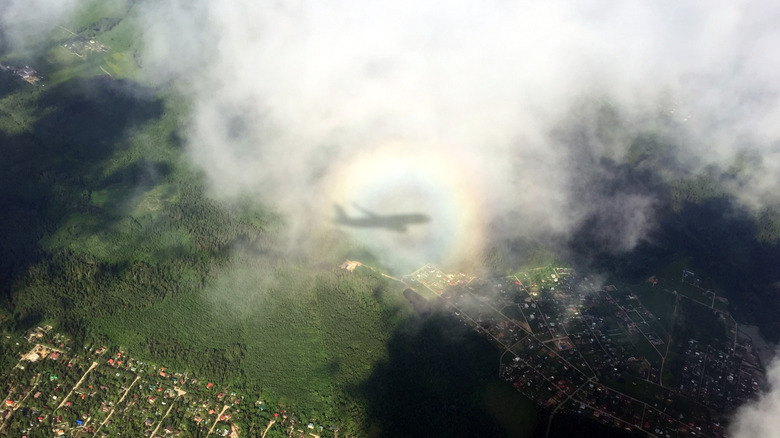What Is Pilot's Glory, The Beautiful And Rare Rainbow Phenomenon?
Pilots are indeed glorious for flying us non-pilots across the world high in the sky in massive husks of metal. But have you heard of Pilot's Glory, the beautiful and rare rainbow phenomenon? Imagine soaring above a layer of clouds and suddenly witnessing a 360-degree halo of colors encircling the shadow of your airplane on the mist below. This captivating sight is Pilot's Glory, or Glory for short, but also has many other names: Pilot's Halo, Glory of the Pilot, and in Eastern cultures, it is known as Buddha's Light. It is one of the most beautiful and rare atmospheric phenomena one can experience. Though far less known than rainbows or regular halos, Pilot's Glory holds a special allure for its ethereal appearance and the unique conditions that are required for its formation.
In meteorological terms, Pilot's Glory is an optical phenomenon that occurs when sunlight interacts with tiny water droplets in the atmosphere. Unlike a traditional rainbow, which is caused by the refraction and reflection of sunlight in raindrops, a Glory is produced by the diffraction of light. Diffraction happens when light waves encounter obstacles, such as water droplets, causing the light to bend and spread out. The droplets responsible for this phenomenon are usually much smaller than those required for a complete rainbow. The result of this is a series of concentric, colorful rings that look like a prismatic halo, typically with red on the outer ring and blue towards the center.
Historical, cultural, and scientific significance of Pilot's Glory
The phenomenon of Pilot's Glory has fascinated humans for centuries, long before air travel was invented. Early mountaineers and climbers often referred to it as the "Brocken spectre" when seen with the additional feature of a shadowy figure in the center. This name originates from the Brocken, a peak in the Harz Mountains of Germany, where the phenomenon was frequently observed. However, the first reported observation was published in 1748 by a French expedition atop the Pambamarca stratovolcano in Ecuador.
In the early 1900s, physicist Gustav Mie devised a mathematical formula to help break down the process that occurs when water droplets backscatter light while suspended in air. Further studies in the 1980s by Nussenzveig and NASA scientist Warren Wiscombe and later publications confirm that the main cause of Pilot's Glory is a process called "wave tunneling." This happens when sunlight gets close to tiny water droplets and creates electromagnetic waves inside it, which then bounce around and pass through as light rays, resulting in the mythical Glory.
This phenomenon is indeed mythical, spiritual even — some scholars believe that the halos in many ancient depictions of deities both in Eastern and Western art may actually be Glories. Culturally, the renowned poem "Constancy to an Ideal Object" by Samuel Taylor Coleridge, penned in 1828, makes reference to it: "An image with a glory round its head; The enamored rustic worships its fair hues; Nor knows he makes the shadow, he pursues!" (via Poetry Foundation).
Where and when can you see a Pilot's Glory?
Glories can be observed from various vantage points, but they are most commonly seen from airplanes or above cloud cover high up in the mountains. When an aircraft flies above a cloud layer with the sun behind it, the conditions are ideal for viewing a Glory around the plane's shadow. The best time to see a Pilot's Glory is early morning or late afternoon when the sun is lower in the sky. This positioning creates a longer path through the atmosphere, increasing the chances of light interacting with the droplets at the right angles. However, Glories are not limited to any specific season and can occur whenever the necessary conditions are met.
For those hoping to witness a Pilot's Glory, a few tips can improve your chances. If flying, choose a window seat on the side of the plane opposite the sun — do some research to find out the relative direction of the plane's travel. The full saturation of a Glory is only visible if the viewer is located between the sun and the water droplets contained in the clouds. This is why being a passenger (or a pilot!) in an airplane is ideal. If hiking or climbing, aim for early morning expeditions and look for opportunities where your shadow can be cast onto cloud banks below you. Whether seen from an airplane window or atop a mountain peak, a Glory showcases the enchanting and fleeting magic tricks of nature.


